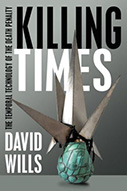Killing Times: The Temporal Technology Of The Death Penalty

Author: David Wills
Publisher: New York: Fordham University Press, 2019. 252p.
Reviewer: Mary Welek Atwell | September 2020
David Wills, a professor of French Studies and Comparative Literature at Brown University, has written an unusual critique of the death penalty. It is one that most readers who approach the subject from the perspective of law or social science may find unfamiliar or even, in part, impenetrable. Wills defines his interest as the “complex temporality of the death penalty.” As I understand this concept, it means the way in which the process of implementing capital punishment intersects with the notion of time—for both the individual sentenced to death and the society that chooses to employ the ultimate sentence on some fairly randomly chosen members. The author addresses how time is significant in the slowly unfolding judicial proceedings, the extended period on death row (often lasting several decades), the “presumed instantaneity of the end of life,” and the imposition of a “precise timetable” for ending a life. Because the individual sentenced to death loses his or her life at a precise moment determined by the state and has been told well in advance, the experience is set apart from other ways of dying—whether natural or imposed by someone else. Wills seeks to analyze the implications of “the state’s interruption of the time of life.”
Some sections of the book deal with topics familiar to students of capital punishment, albeit in a non-traditional way. Wills reviews some major Supreme Court decisions and the (futile) efforts of the justices to make the modern death penalty compatible with the Constitution’s prohibition of cruel and unusual punishments. He discusses at some length the views of Justice Clarence Thomas. Not only skeptical that the Constitution requires that the method of execution conform to “evolving standards of decency,” Thomas seems to believe that a vicious crime excuses the state from any blame for inflicting a tortuous death on the perpetrator, and that therefore the Court should grant states a virtual carte blanche to punish as they see fit. Many others would agree with Justice Harry Blackmun that it is futile to “tinker with the machinery of death” in the hopes of creating a death penalty regime that can be carried out fairly and humanely, and that therefore the only answer is abolition. The latter is clearly the author’s position. But unlike many critics of capital punishment, he seems to locate the ultimate cruelty of the death penalty in the “artificial interruption of human temporality.” For Wills, even if a painless method of inflicting death could be developed, it would not fix the overriding problem that it is always unacceptable for the state to “set the alarm clock” on human life. This seems to me to be his basic position, but the deconstructionist approach makes his arguments hard going for those not schooled in that perspective.
Wills examines methods of execution, as he argues that the way in which a person is put to death frames the sense of the moment at which life is extinguished. The guillotine introduced the notion that death could be imposed with temporal precision. The head would be severed, blood would flow, and in that instant the condemned person would be surely dead. There are those who have argued for the guillotine as a humane method of execution because it does its work so quickly and does not prolong suffering. The latter factor became a measure to evaluate the acceptability of methods for the state to kill, and underlies objections to the use of lethal injection when the condemned person lingers in the throes of death. On the other hand, the instantaneous death by guillotine involves profuse bloodshed. Aversion to the bloodiness of that method of death figured into widespread decisions in the western world to find non-sanguinary alternatives. Thus hanging, the electric chair, and ultimately lethal injection became the favored execution procedures, despite the likelihood that they prolonged the process of dying.
In the last three chapters, Wills moves from such relatively familiar concerns about capital punishment to more esoteric and philosophical arguments. He speculates at length about the similarities among suicide bombers, victims of drone strikes, and executed individuals, focusing on how in their deaths they experience the meaning of time. He cites and quotes at length from several rather obscure French sources, for example, a murderer’s memoir from the mid-eighteenth century that may be familiar to scholars in his discipline. However, that discussion and other more abstract sections are not likely to resonate with those trained in the social sciences. These latter tend to ground their reasoning against the death penalty in more specific objections to laws and procedures.
Some opponents of capital punishment may welcome all like-minded arguments, regardless of their obscurity or level of abstraction. Others may wish for allies who zero in on points that are likely to build support for abolition. Wills’s claims about time and the death penalty take the reader into territory where many seldom venture and where few activists are likely to follow.
Reviewed by Mary Welek Atwell, Professor Emerita of Criminal Justice, Radford University


